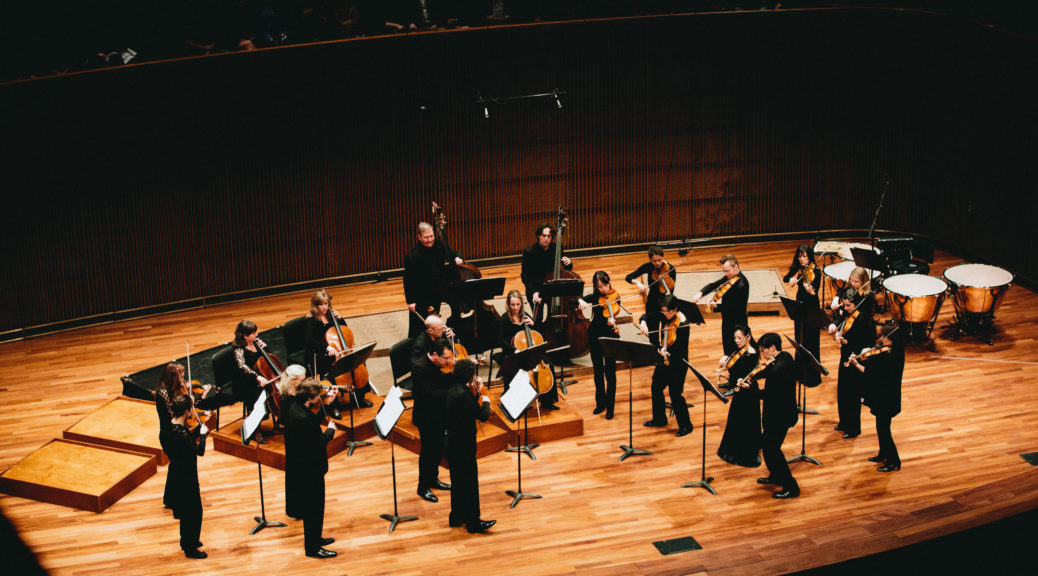
BISS’ IRON-MAN FEAT: SIX CONCERTOS IN THREE DAYS
BERKELEY, CA—-The St. Paul Chamber Orchestra has been a thriving outfit for some 59 years despite two burdens that most orchestras work hard to avoid, fearing unpalatable ticket sales: Lack of a conductor/music director, and the title word “chamber” in place of “symphony.” Further playing down any star power, the group dons black no-necktie outfits, and it has two violinists alternating in the concertmaster’s seat.
The saving grace comes on two fronts: an excellent ensemble, containing close to one-half women, and terrific musical performance. Any doubts about the group’s prowess were dissipated with the rousing play of Mendelssohn’s pulse-quickening “Italian” Symphony (No. 4) on tour here Feb. 9.
Also the SPCO innovates with its unusual concert juxtapositions: Play a Beethoven, then play a new work inspired by the latter. The procedure resembles the “Call and Response” format we’ve encountered elsewhere in smaller groups. You hear the masterwork, then the original new piece patterned after the old one, but so different you’d probably never pick up the relationship. Over three days the SPCO plays three different Beethoven piano concertos, then their new ‘relatives’ composed by Timo Andres, Salvatore Sciarrino and George Tsontakis.
If there are only the barest similarities within each pair, it’s that no one wants to be called a plagiarist, though as a concert-goer, I’d welcome picking up a few more clues of recognition here and there. In each pairing, pianist Jonathan Biss does double duty. All told, he does the iron-man assignment of six different concertos over the weekend Feb. 9-11.
The first new work was “The Blind Banister,” a piano concerto by the American Timo Andres, 32. It used trills and tremolos generously and, like the matching Beethoven (No. 2), it emphasized downward-moving themes and scales. This is a big, quirky laying out of conflict with brass battling woodwinds, and later a cadenza with a rain-shower of flying notes.
It’s a restless work that wants to break the confining bounds of the Beethoven in all dimensions, constantly inflating itself into another realm from Beethoven’s Second, punctuated with unsettled percussion. Building up, it features an explosive movement, a shriek of brass, and vivid strikes on the kettle drums. The ending provides a wakeup call, with a magnetic chaos decorated with tamtam and bass drum, finishing with a loud, abrupt cut-off. This work, and this work only, was conducted by Joshua Weilerstein.
Jonathan Biss impressed me most in one of Beethoven’s rarely played concertos, articulating every fiber in his lucid reading. It’s an enigma of a piece, with an almost invisible piano part in the second movement—one in which many a pianist used to interpolate impromptu notes, in the manner of Mozart. The highlight is the cadenza of the opening movement, which the composer added many years later, showing off the mature style as he knew it from his late sonatas.
The orchestral highlight was Mendelsssohn’s last numbered symphony (No. 4, “Italian”) , which was bright and luminous in its rapidity. It was played by some 40 musicians, half of whom were women—a much higher percentage than we encounter in our California symphony orchestras.
MUSIC NOTES—In most conductorless ensembles, the unified rhythm is set by the bow movement of the concert master. But what about assuring good balances between sections of the ensemble, with an empty podium? One musician claimed it was no problem achieving it all in rehearsal: “We just do it!” End of argument.
St. Paul (MN) Chamber Orchestra, with new works by Timo Andres, Salvatore Sciarrino and George Tsontakis; and Beethoven. Zellerbach Hall, Berkeley. For info: 510-642-9988, or go online.